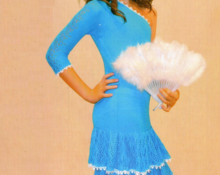 The range of knitted items created by craftswomen is amazing. And over time, any accessory accumulates a lot of different variations. the same thing happened with the scarf. Its original variation, called bactus, is especially popular among modern fashionistas. It can be made by knitting or crocheting. But the least time-consuming will be production on a knitting machine. Let's look at how this is done.
The range of knitted items created by craftswomen is amazing. And over time, any accessory accumulates a lot of different variations. the same thing happened with the scarf. Its original variation, called bactus, is especially popular among modern fashionistas. It can be made by knitting or crocheting. But the least time-consuming will be production on a knitting machine. Let's look at how this is done.
What is needed for knitting bactus on a machine
Despite the apparent simplicity of the model, this work requires careful preparation. To do this, you need to perform the following steps.
- Choose the appropriate form: narrow model, isosceles triangle, asymmetry, semicircle and so on.
- Decide on the knitting direction canvases. It can be made from the wide side to the corner, from the corner to the wide side, from one corner to another or diagonally.
- Pattern selection, which is carried out in accordance with the taste and preferences of the future owner.
- Making a sample. As in the manual method, the machine version requires detailed calculations, which are carried out using a pattern and sample.
Important! The sample must be subjected to wet-thermal treatment. In this case, subsequent calculations will be more accurate. Hidden defects in the material (stretching, shrinkage), if any, will also appear.
Besides, special attention is required to the starting material for manufacturing. It is best to use special yarn for machine knitting. But if this is not available, you can use the option for hand knitting of medium and low density with parameters 400–600 m/100 g.
How to knit bactus on a knitting machine
To understand the creation process itself, let's look at creating a diagonal scarf step by step.

To realize you you will need a plain mixed yarn (wool/acrylic) with parameters 500 m/100 g.
Description of work
- Knit a sample pattern on a knitting machine, which is formed by yarn overs.
Attention! In machine knitting, you can use two ways to knit increases. First: throwing a loop onto an adjacent knitting needle next to the outermost loop. Second: using a decker, shifting the two outer loops through one position.

- Calculate increases and decreases based on the sample and your measurements. In the diagonal process, increases and decreases are made on both sides of the canvas simultaneously.
- Cast on the estimated number of stitches to start knitting and purl six rows.
- Next, perform a row of yarn over patterns.
- Then knit a hem that imitates a stem. To do this, knit as follows: knit 2 stitches, yarn over.
- Knit a pattern of yarn overs in a mirror image.
- Continue the fabric according to the pattern: 10 rows of purl stitch, a row of hemstitching.
- Continue until the product reaches the desired height.
- Close the loops.
A product created with your own hands can not only be worn, transforming your appearance, but also used as a gift for loved ones or colleagues. Happy creative work and smooth stitches!


 0
0






Where is the drawing diagram? Description of the idea?
Hello Vera! Sorry, at the time of publication of the article, there were no diagrams.